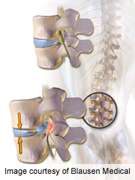Most cases of lumbar disc herniation are caused by endplate junction avulsion rather than by annulus fibrosis rupture, according to a study published in the Aug. 1 issue of Spine.
(HealthDay)—Most cases of lumbar disc herniation (LDH) are caused by endplate junction (EPJ) avulsion rather than by annulus fibrosis (AF) rupture, according to a study published in the Aug. 1 issue of Spine.
S. Rajasekaran, Ph.D., from Ganga Hospital in Coimbatore, India, and colleagues studied 181 consecutive patients requiring microdiscectomy at a single level. Plain radiograph, thin slice computed tomographic scan, plain and contrast magnetic resonance imaging (MRI), intraoperative examination, and histopathological analysis were used to assess the status of the endplate and AF in the operated level (study discs) and the other discs (control).
The researchers found that LDH due to EPJ failure (EPJF-type I herniation) was more common (117 discs; 65 percent) than annulus fibrosis rupture. There was a significantly higher incidence of EPJF in herniated discs than control discs. On radiographs, the EPJF was present as vertebral corner defect in 30 patients, rim avulsion in 46, frank bony avulsions in 24, and avulsion at both upper and lower EP in four. Intraoperatively, cartilage or bone avulsion was seen in 13 discs with normal EP radiologically. Intact EP was seen in 64 discs (35 percent), of which annular high intensity zone was found in 21 (11 percent), suggesting a disruption of AF (type II herniation). EPJF was proven to be the main cause of LDH in 20 patients with post-contrast MRI that showed dye leak at the EPJ.
"Our study provides the first in vivo evidence that LDH in humans is more commonly the result of EPJF than AF rupture and offers clinical validation of previous in vitro mechanical disruption studies," the authors write.
More information:
Abstract
Full Text (subscription or payment may be required)
Journal information: Spine
Copyright © 2013 HealthDay. All rights reserved.
























